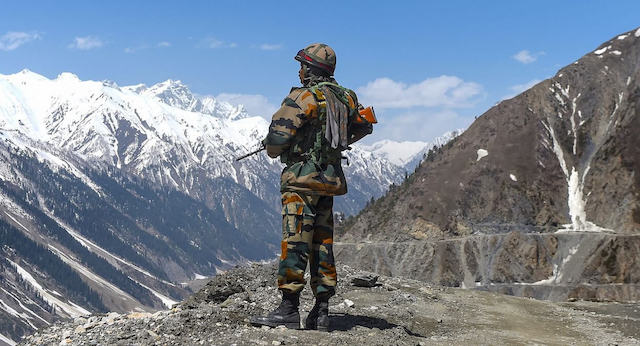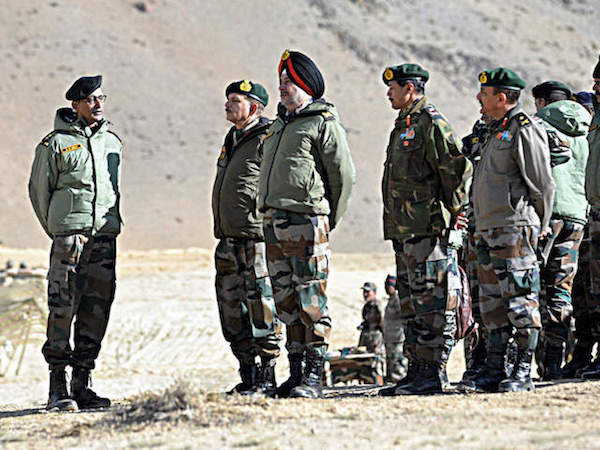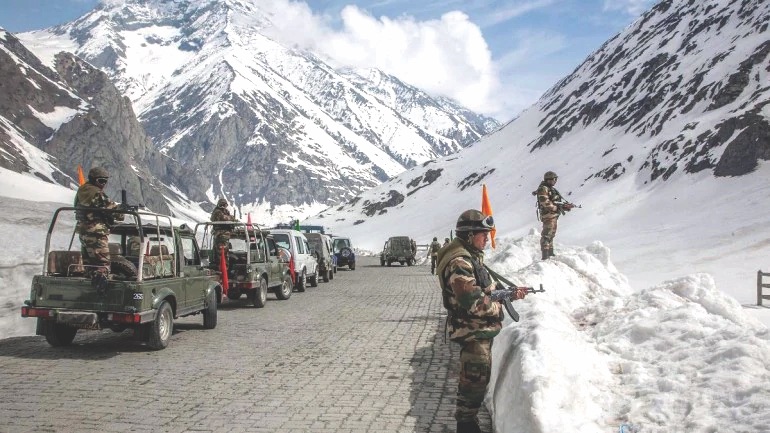The India-China ensuing discord is an opportunity in disaster to collectively rewrite a new equation of delimitations and suzerainty. The region has had enough of militarism. It’s time to give peace a chance.
CHINA AND INDIA are needlessly involved in border skirmishes that could hardly serve any purpose of geopolitics. Rather, it would swing in an era of instability, and provide an apt opportunity to secessionist movements in the restive zones on both sides of the border to axe their grind.
The conflict, moreover, has come at a wrong and ill-advised moment for Beijing, as it was on the anvil to focus its synergies on global leadership — taking into account the ongoing trade war with the United States, and the former’s desire to see the Road and Belt project usher in a new power paradigm of prosperity in Asia, Middle East and Africa. Any distraction for China, as the world is sliding into a pandemic-led recession, is uncalled for.
As far as India is concerned, it is unlikely to gain anything. Engaging China militarily is neither an option for Delhi, nor could it take the risk. History is testimony to the fact that India’s jingoistic designs in the region had weakened it at home, and exposed its vulnerability. Thus, fighting a proxy battle or seeing troops from both the sides champion their muscles – as they engaged in brawls and fist fight – is an exercise in futility.
According to the SIPRI Military Expenditure Database published in April 2020, from 2010–2019, China increased its military expenditures 85 per cent, whereas India enhanced its allocations by 37 per cent. It is a perfect mismatch, and thus no need to even think of a showdown at the altar of world peace.

Let’s take an unbiased look at the jaundiced geography in the region. The scenic Himalayas had been a theatre of political and military rivalry between the three empires of Britain, China and Russia. At this point of time, the ongoing clashes in the Galwan Valley, close to Aksai Chin – a part of Xinjiang — is a déjà vu for India. Delhi has found itself trapped in the region at least thrice since the 1962 crushing defeat at the hands of China. Though the area is controlled by China, India stakes its claim, too.
Terrain-wise the Aksai Chin region – the world’s largest frozen lake at 14,500 feet above sea level — is considered by geologists as part of greater Kashmir and Ladakh — the land of high passes. Thus, India and China cannot stop contesting each and every inch of the territory, as it is more of strategic depth to them than a point of glory to stay put on one of the most inhospitable and uninhabitable plateaus that witnesses temperature drop below (minus)30 degree Celsius.
So what is the fuss? While India recognized the so-called ‘McMahon Line,’ a legacy of the British era, China never formally accepted it. The Communist government’s argument since 1949 had been that it believes in the theory of “borders of habit”, as people of Tibet — known as the Roof of the World — and other adjoining regions are in same bloodline.
To the annoyance of Beijing, New Delhi maintains that the McMahon Line is the official legal border. That was never to be like that. The 1962 war altered that demarcation. Chinese troops crossed the McMahon Line and Prime Minister Zhou Enlai in the wake of a cease-fire laid down a new frontier, which is now known as the Line of Actual Control (LAC), an aspect shunned by India to this day.
This is why the recent skirmishes have a history of trial and tribulations. China, of late, flexed itself on the Road and Belt project, as it started building new communication infrastructure in the region. India, which is skeptical not only to the Belt project that would allow a land-linkage to China into Southeast Asia, is also dead against the advancements being made on the $60 billion China-Pakistan Economic Corridor. That is why it built a new all-weather road in the region that runs very close to the LAC.
Why is India so obsessed with Chinese activities? Again we have to peep into history. In 2017, Beijing built a road in the Himalaya’s Doklam Plateau that links it with Bhutan. Thus, for Delhi it was like the Dragon sitting right on its shoulder. It goes without saying that Bhutan is technically a client state under Indian tutelage. Likewise, according Ladakh the status of Union Territory and scrapping of Article 370 on Kashmir was geo-political squabbling.
A full-fledged war, nonetheless, over the LAC is out of proportion. True to the Chinese mindset, they don’t believe in militaristic adventures. Taiwan and Hong Kong are cases in point. China has a greater business in manning the South China Sea, and securing its interests in the Pacific Ocean, than flying sorties over the Himalayas.
Yet, India wouldn’t mind drawing China in for public consumption. But a fragile and battered administration in Delhi should think a hundred times before stepping on the Dragon’s tail. To this day, hardly has the BJP government come up with a clear picture of what has happened across the LAC!

So what is the bravado all about? Why are regional countries so curious to see them go to war? What American interests’ would it serve? And, why is Pakistan hoping that another defeat of the Indian Army would provide it with an opportunity to prove that Delhi has wronged on too many fronts? Similarly, it would be futile to believe that a victorious China will help Pakistan get closer to its goal of liberating Kashmir. That didn’t happen even in 1962, whereas it was one of the most opportune moments in history to walk over Kashmir, had Beijing hinted at it!
Technically, the current clashes have nothing to do with Pakistan or the United States, per se. It is a pure bilateral issue between China and India and the least that should be bothered are Tibet and Bhutan, as they would find themselves sandwiched between two major military and populous powers.
As rightly stated by an Indian analyst, the LAC skirmishes came as a surprise for Delhi. The pressure on Prime Minister Narendra Modi was to “respond immediately, and that too in exasperation.” Just as Jawaharlal Nehru did in 1962! Even then, and now, Chinese enjoy the cutting edge. The Chinese are in their habitat, whereas India is moving its forces upward from plains to tricky mountains, and are likely to face adaptability problems in the terrain.
India’s nightmare is its cynical geography – just like East and West flanks of Pakistan before 1971 had a hostile territory in between. Terrain-wise, India is divided in two regions separated through the Siliguri Corridor. It is also known as the Chicken’s Neck. It becomes all the most indispensable in times of a clash with China. The 17-km belt also links it with Bangladesh, Sikkim and Bhutan. As Beijing built new roads in the region, it has rung alarms in the South Block of Delhi. If China somehow dissects the Chicken Neck, India will be truncated with its seven eastern-lying states. While adventuring over the LAC for long, India has to keep this vulnerability in mind. The earlier a truce is struck, the better.
As Morgenthau, the German strategist, said power equations are too tough to remain bilateral for long. So is the case at the moment in the region. Rather than projecting bravado of China, or the dilapidated equation of India, the need of the hour is to utilize this opportunity in disaster to negotiate a broad-based narrative of power equilibrium. This can only be done by addressing the unresolved territorial disputes through a dialogue process. All it needs is the will of the nations to give peace a chance.
Even if India and China indulge in a showdown for long, hardly anything would change on ground. A few hundred miles of advancement allegations — here and there across the LAC — would be the new matrix. Even if India is battered shamelessly, will it help anyone in the neighborhood? Other than playing to the gallery in terms of nationalistic sentiments, it would serve no other purpose. To the discredit of all the stakeholders, the region will rather plunge in chaos.

The onus is on China to exercise statesmanship. The moment Beijing and Delhi sit in with the intention to act as responsible powers; they will be under compulsion to rewrite a new chapter of regional harmony. This exercise should not be limited to bilateralism. Trading land for peace will not result in political annihilation; rather it would set in a grandiose moment of prosperity and confidence.
That applies to all under-lying disputes in the northeast as well as Kashmir. Similarly, the politico-legal entanglements with Bhutan and Sikkim, respectively, could be addressed in a more comprehensive manner. It needs to be mentioned that China considers Sikkim as its integral territory, as it wasn’t part of India before 1975. A Chinese claim that has parallels with Taiwan. This is how adversaries can reach a win-win situation.
It can’t be ignored that when it comes to diplomacy, China has a lot of maneuvering tools over India. The manner in which Dalai Lama’s spiritual resurgence had been neutralized is a case in point. There is no news from Dharamshala these days — once the bastion of the Tibetan leader in India. In a quid pro quo agreed with China, India had little to regret as it wrote-off the proxy Yellow Hat leader!
China is proactively engaged and in recent times has emerged as the biggest trade partner and investor in the region. It has pumped more than $93 billion in the Middle East over the last 10 years. Likewise, it has thrown a staggering $60 billion on the dream project of CPEC – linking the mainland to the Arabian Sea and downward to the African continent. Last but not the least, are the deals with Iran to invest around $400 billion in the next three decades.
India’s nervousnessis understandable. China has made inroads in foreign policy with Sri Lanka, Bangladesh and Nepal, India’s once allied-allies. At the same time, the Belt and Road project has made it strategically indispensable to Pakistan. Islamabad for the last more than five years – since General Raheel Sharif took a leap success in war against terrorism — is in the Chinese camp, irrespective of being a preferred wheeler-dealer for Washington when it, especially, comes to Middle Eastern affairs.
The current ensuing crisis has pitched India in a new dilemma of power paradigm. This real-politick brings it closer to the United States. There is a lot that Delhi can do to serve Washington’s interests in South China Sea and deep in the Indian Ocean and Pacific Rim sea-lanes that are currently under aggressive US surveillance and patrolling. From Guam to the Straits of Taiwan, Washington’s one point agenda is to check China’s naval buoyancy. American warships are out in the deep seas, and despite Covid-19 breakout on its vessels, patrolling has not been called off.
But the million-dollar question is will India risk taking China head-on on the flimsy promises of the United States? Has Washington delivered on its pledges ever – to anyone in the region? Pakistan’s plight in Afghanistan and the Fall of Dhaka are lessons in history. India with a gigantic geography right under the belt of China will be ill-advised to fight on two fronts: on ground over the LAC and in the sea lanes as America’s myopic ally. It’s time for new calculus and a decisive shift in thinking process. Delhi should befriend its neighbours, and stop pushing them to the wall.
Important questions are in need of being addressed holistically. If unhindered trans-regional trade and movement of men and material are sine qua non for collective development and prosperity, then a multilateral consortium of adjudicators should be set up. The mandate under international law should be to do away with territorial bad blood and reach a new understanding in terms of delimitations and suzerainty. Time to do away with the stigmas of LAC and LOC! The region and its more than 3.5 billion people have had enough in the disguise of state repression and non-state actors. Let jingoism take a back seat, and rationale to life and welfare triumph.




